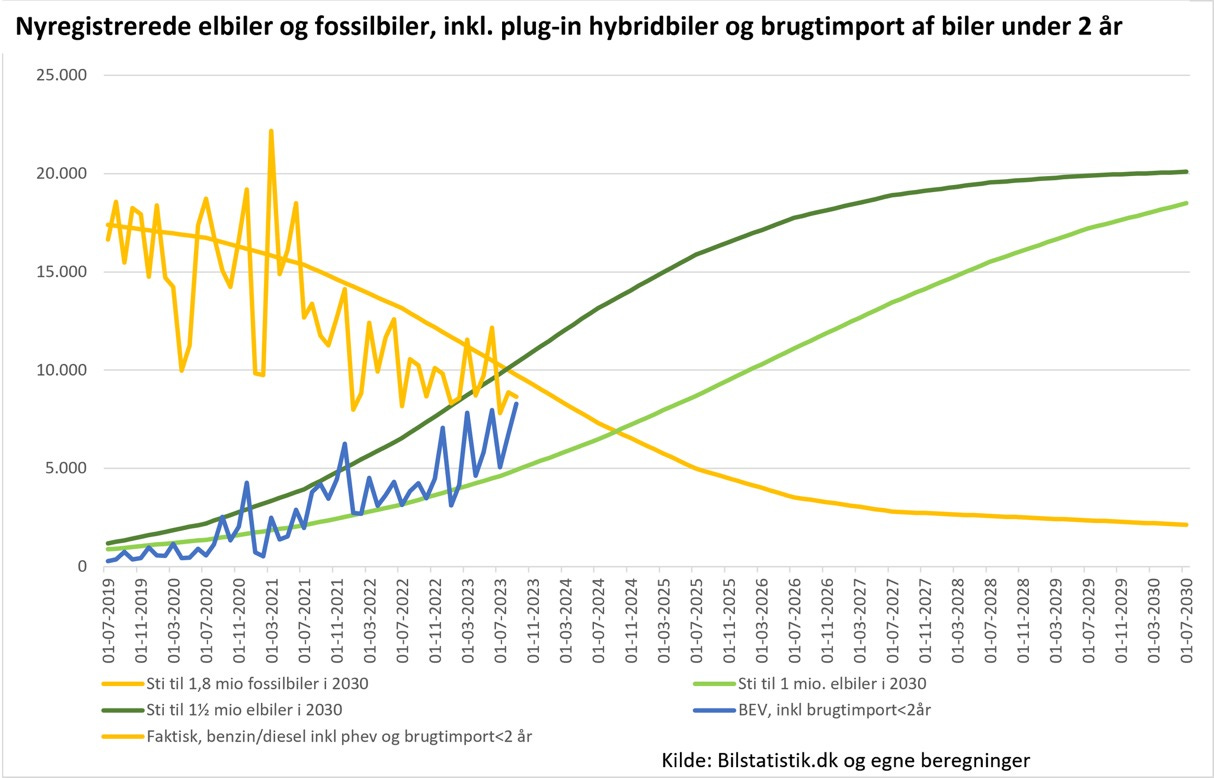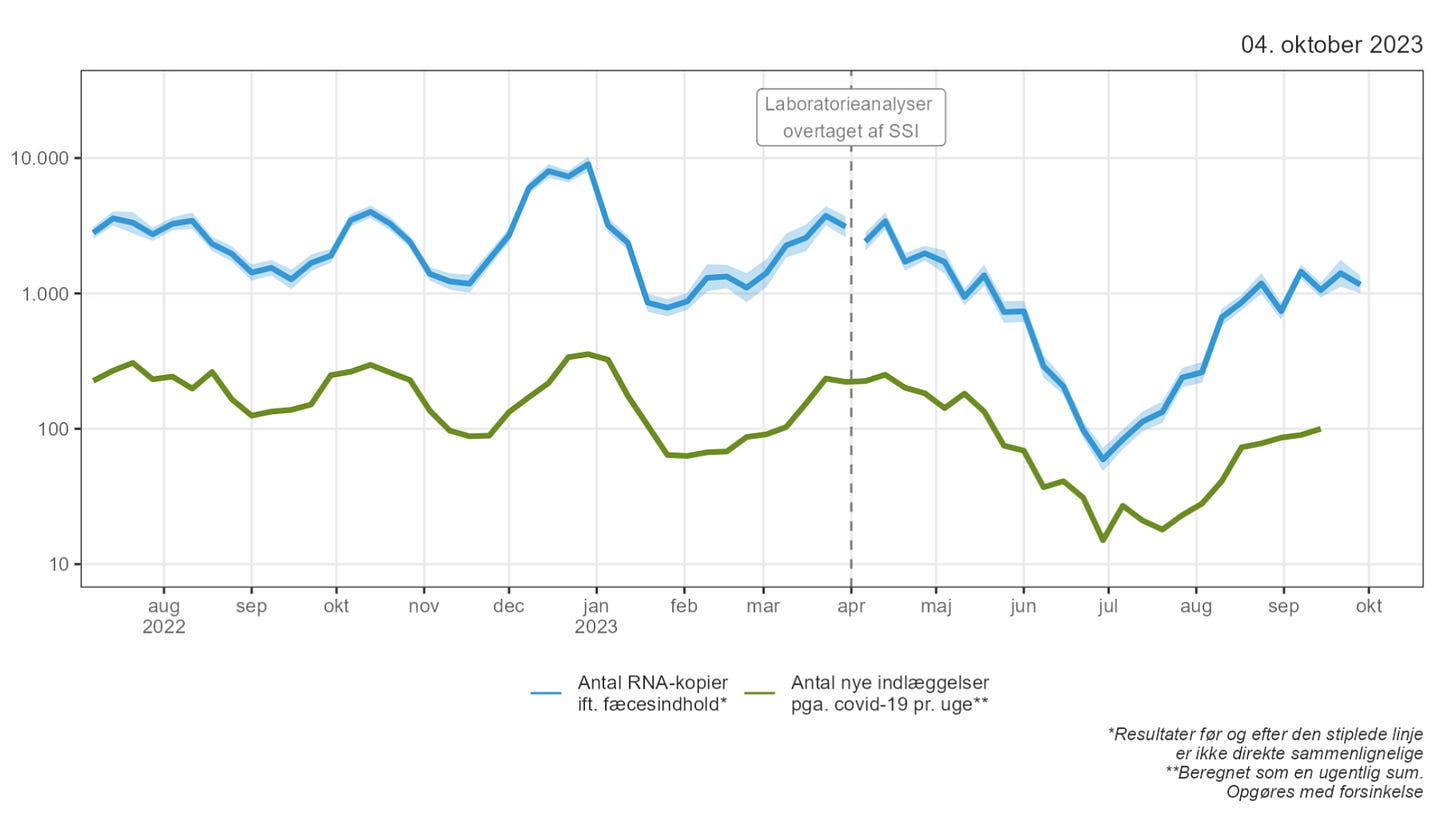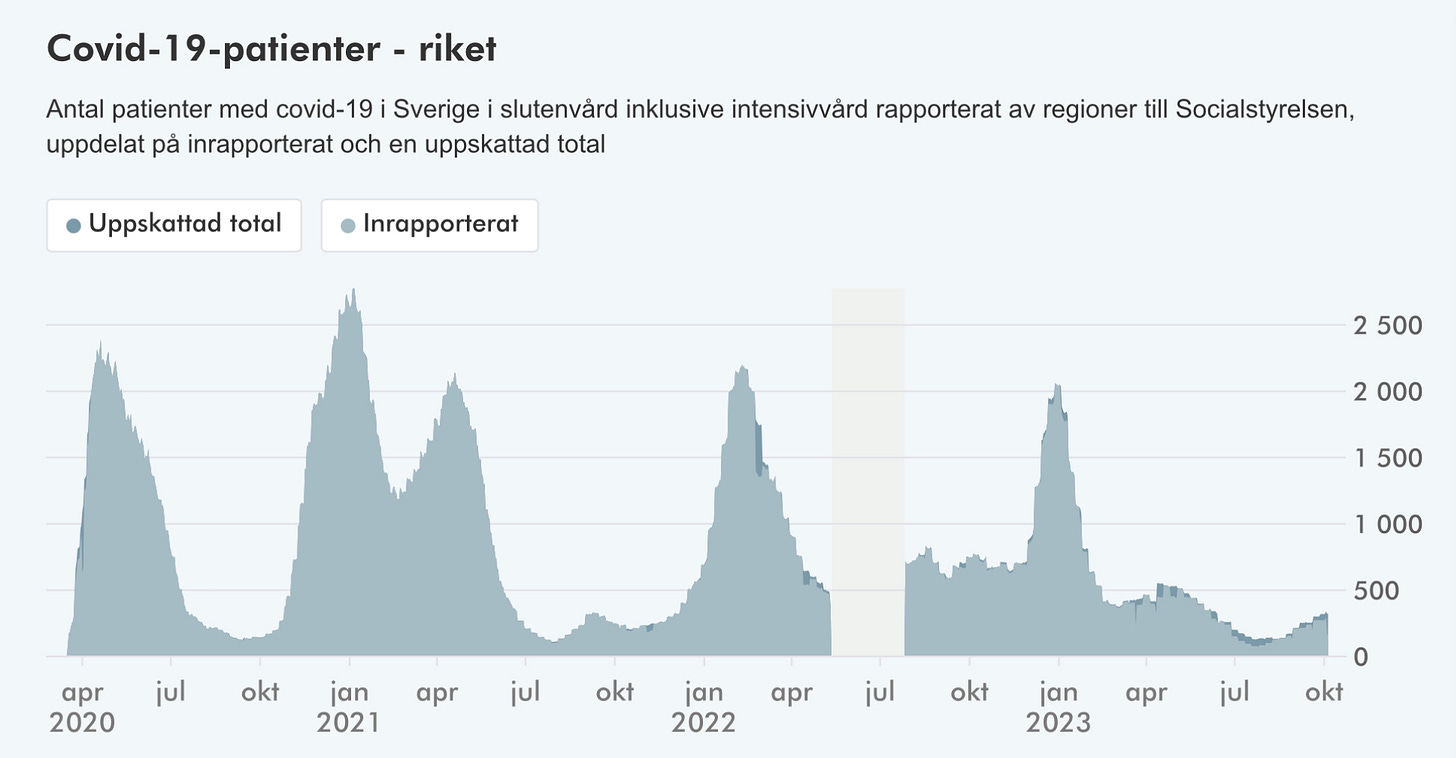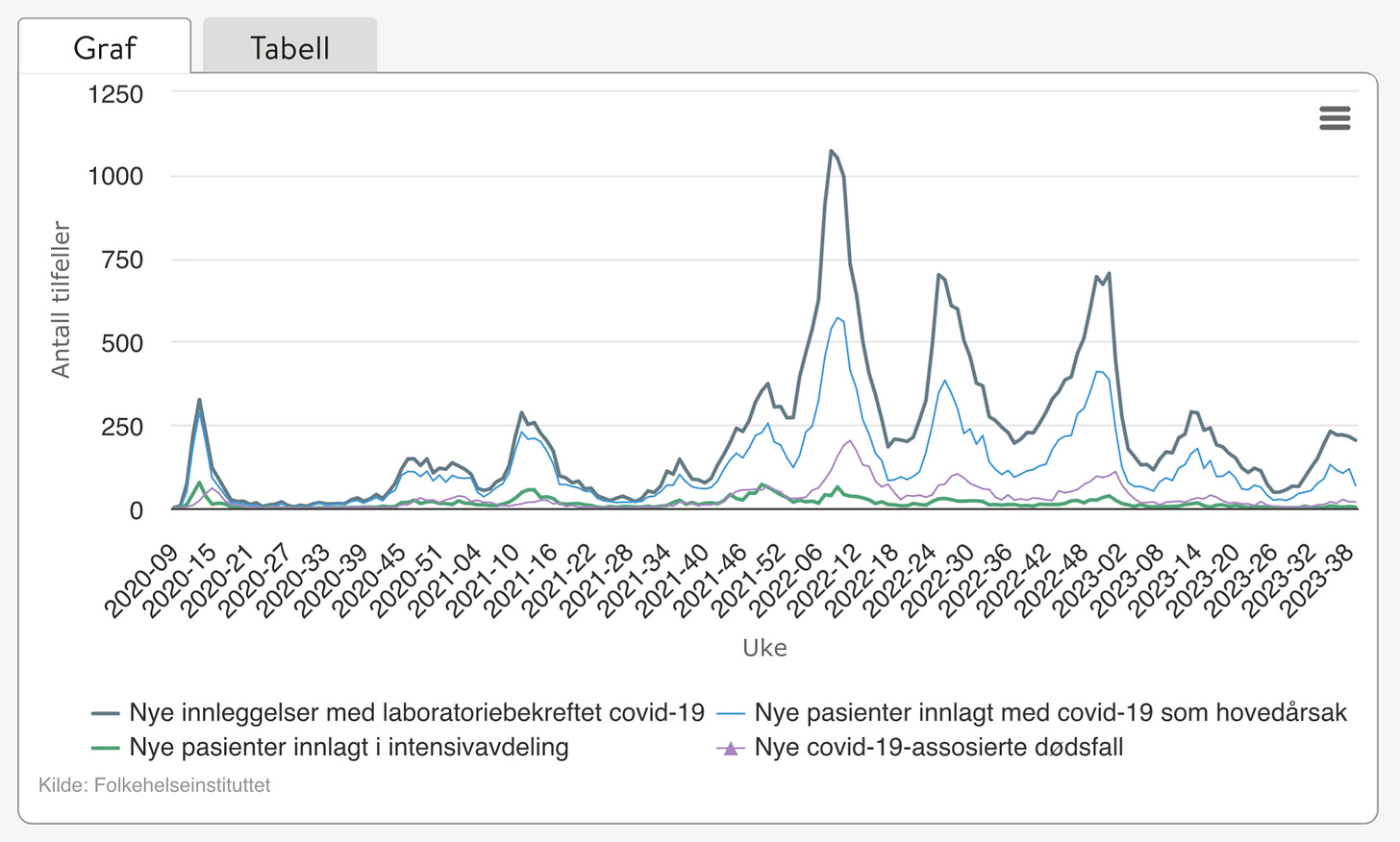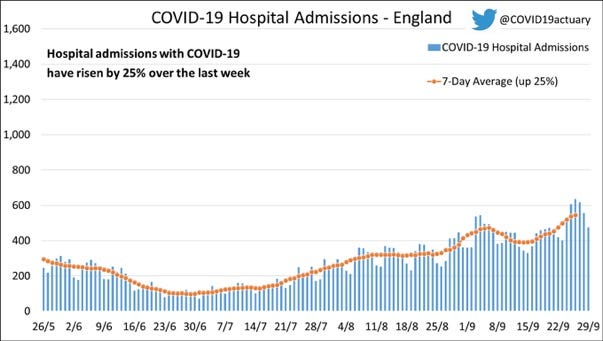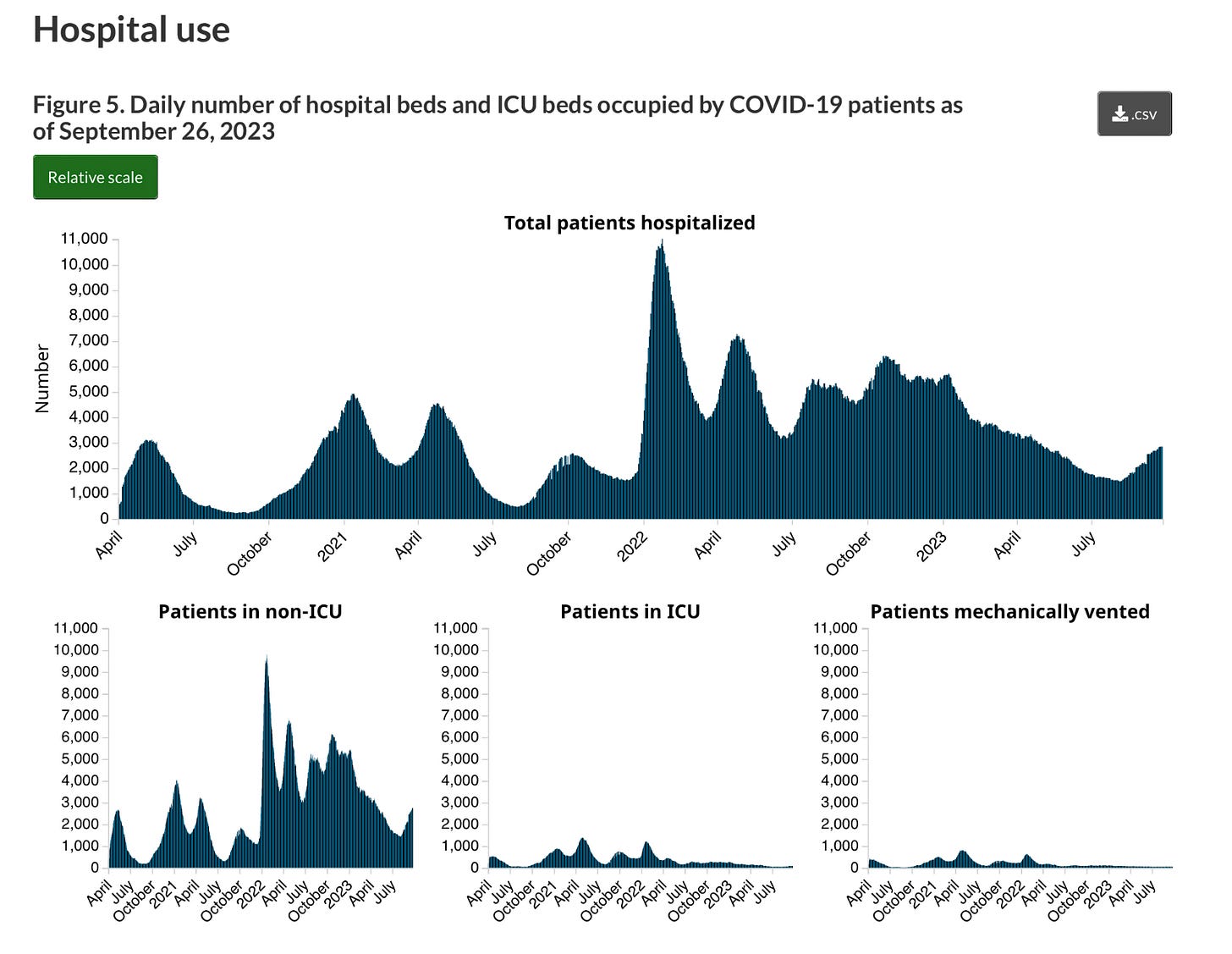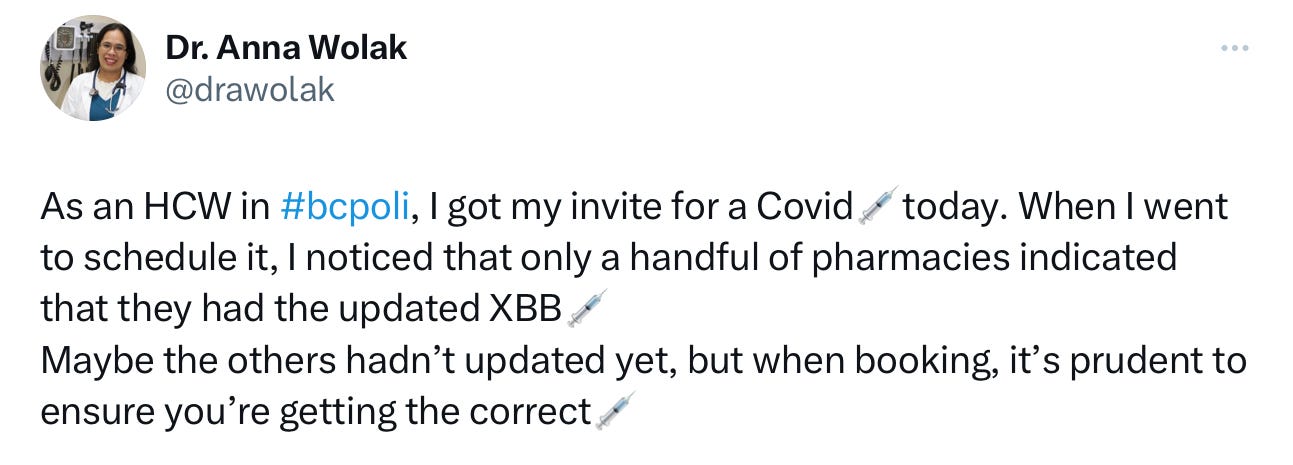🍃Environment & Energy⚡️
🇩🇰
A swath of central Jutland was hit by an epic cloudburst on Tuesday flooding roads, supermarkets, and homes. The Danish Meteorological Institute says it has never seen such a large cloudburst with the downpour covering a full 11% of the country. DMI began keeping statistics on cloudbursts in 2011 and says to date nothing that large has ever been recorded in Denmark.
All the flooding has had a rather gross side effect. A countless number of drowned rats have been washing into the sewage treatment plant in Aarhus. The plant operator says in serious flooding events with pipes being overwhelmed the water floods all the underground rat burrows. Workers say in all the years they have worked there they have never seen the sheer volume of drowned rats that are now washing into the plant.
-
It is official, it was the warmest September on record in Denmark. The Danish Meteorological Institute says the average temperature last month was 16.3 degrees, which is the warmest ever recorded for any September since records began to be kept in Denmark back in 1874. The previous record was 16.2 degrees, which was set in 1999 and then matched in 2006 and again in 2016.
September was also warmer than either July or August in Denmark.
September saw more weather records being broken with nine days in a row with temperatures of 25 degrees or hotter. That has never happened before according to DMI. Odense also saw temperatures hit 28.5 degrees on September 9, the highest since the city began monitoring weather statistics in 1959. A number of other regional weather records also fell across the country last month.
🇫🇮
It wasn’t just Denmark, it was also the warmest September on record in Finland. The Finnish Meteorological Institute says with an average temperature of 12.2 degrees it just broke the old record of 11.8 degrees set back in 1934. The weather agency says September is warming up and is now roughly 2 to 3 degrees warmer than it was on average between 1991 to 2020.
Institute Meteorologist Jani Sorsa spoke to Yle:
“Warm air has been flowing here for much of the month. Usually in September, cooler air from the north blows in, but this time it only reached the northern parts of the country for a few days."
🇪🇸 🔥
Evacuations are underway again on the Spanish island of Tenerife as another large wildfire has flared up. Back in August a big wildfire also forced evacuations. That wildfire was eventually brought under control, at least until now. There is conflicting information about whether this latest blaze is a brand-new wildfire or if high winds have reignited the old one. So far about 3,000 people have been ordered out of their homes. With strong winds and hot temperatures the situation could get worse before it gets better.
🇪🇺 🇫🇷 ⛰️
Western Europe’s highest mountain peak is shrinking. The summit of Mont Blanc now measures 4,805.59 meters above sea level. That is over two meters shorter than when it was last measured two years ago. The peak usually has a thick covering of ice and snow, which impacts the measurement of its height, but with climate change, warmer temperatures, and a lot less rain over the past summer it is all taking its toll. The mountain’s height is measured every two years.
🇩🇰
Electric vehicles continue to take over in Denmark. Last month there were 8,296 new EVs registered in Denmark, just 345 fewer cars sold than ran on fossil fuel according to bilstatistik.dk. That is a new monthly record for the number of new EVs hitting the roads and those numbers continue to trend upward even as fossil fuel vehicle sales drop.
-
As of October 1, it became illegal to drive certain diesel-powered cars in the centers of Denmark’s four largest cities. The Danish Environmental Agency says within the first 24 hours of the ban being introduced it issued 357 fines. Most of those (211) were handed out in Copenhagen with 77 more issued in Aarhus, 43 in Odense, and 26 in Aalborg. Enforcement is done by camera, which registers a vehicle’s license plate, if it is a diesel car without the required particle filter then a fine is issued.
🇩🇰
The population of whales and porpoises in Danish waters is less than half of what it was a year ago. That is the result of a count done by researchers who counted the number of whales and porpoises in small specially equipped planes. They counted about 14,000 a number significantly lower than what was tabulated last year. The count was part of a larger European-wide effort from Spain to Norway in order to get a better handle on whale populations.
Danish researchers say that the population of porpoises (marsvin in Danish) in internal Danish waters from the Kattegat to the big and little belts has been exceptionally hard hit. This is the same area impacted by extremely low oxygen saturation that is chasing fish stocks away and killing invertebrates.
The count is of course subject to uncertainties due to the method of trying to count animals living underwater by airplane.
🇩🇰
Christmas lights and displays may make a return in Denmark this holiday season. Usually, December is awash in the spirit of Christmas across the country as everyone goes all in markets, events, and seasonal light displays but due to last winter’s energy crisis, the lights were allegedly left off. While the Danish Energy Agency is still urging conservation a number of large chains and municipalities have already said Christmas light displays are going back up this winter.
Coming off of the warmest September on record in Denmark, and across a swath of Europe, weather remains the ultimate wild card. Last year’s energy crisis was largely averted due to a record-breaking winter heat wave across much of Europe. But if Old Man Winter slams the continent into a deep freeze this winter then it could mean significant energy challenges.
-
Gas and diesel prices may soon drop. The price of a barrel of oil on international markets has dropped to $86. Sydbank Senior Economist Kim Blindbæk told Ritzau that rising interest rates and the increasing value of the dollar are possible factors in driving down oil prices.
“Higher interest rates draw activity out of the global economy, and a stronger dollar makes the price of oil more expensive because the oil is settled in dollars. At some point, we will hit an invisible dividing line where investors judge the price of oil to be too high. We could be hitting that dividing line now.”
The result should be that as oil prices fall it will also drag down the price at the pump.
🇸🇪 🇩🇰
Sweden’s ailing economy seems to be good for tourists. The Øresund bridge connecting Denmark to Sweden recorded a record-high number of crossings. In July 923,496 passengers crossed the bridge and now in September, the bridge operator says the volume of crossings continues to be sky-high. Traffic across the bridge last month was 14% more than it was a year ago. The bridge operator says the dropping value of the Swedish kroner is likely a big factor in the number of crossings.
🇩🇪
Germany is extending its emergency energy measures introduced last year over this winter season. Due to scarce gas supplies, German lignite coal-fired power plants will remain on standby should freezing temperatures reignite the energy crisis. The lignite plants can produce about 1.9 gigawatts of electricity if needed. The main purpose of these types of coal-fired power plants is to push gas out of power markets during peak demand as a mechanism to keep prices low.
Lignite coal is also the most polluting type of coal and if called into use will add significantly to Germany’s greenhouse gas emissions. Germany had been aggressively shutting down its coal-fired power plants until last year’s energy crisis caused the government to press pause on phasing out, and in some cases even reactivating its coal-fired power plants.
🇫🇮
Food prices will begin to decline next year. That is the assessment of the Finnish Pellervo Economic Research Institute in its latest Economic Agriculture and Food Forecast Report. The institute is projecting food prices to drop by about 2% in 2024.
However, while the drop in prices, if it comes to fruition, will be welcome news for consumers it doesn’t amount to much in the big picture. This year food prices in Finland are expected to have gone up by about 8.5%. Even if the inflation rate on food slows and begins to ease, prices will still be around 20% higher than they were just a couple of years ago. The institute’s forecast states that it is highly unlikely food prices will return to those levels anytime soon.
The report notes that the inflation picture for groceries remains complicated. Even as the cost of staples like grain, milk, and some meats are beginning to decrease the prices for other items like sugar continue to climb, which will have a ripple impact, especially for processed food prices.
The institute’s quarterly forecast says that families are becoming much more budget-conscious as inflation drives up the cost of living. It says there has been a noticeable decline in the purchase of beef products and even pork sales are slowing as people switch to cheaper chicken or plant-based options.
🦠COVID🦠
🇩🇰
The latest fall and winter vaccination campaign is off to a good start across Denmark. The Danish Health Authority says in the first three days 179,684 inoculations have been administered. So far, 5.6% of those eligible for a COVID booster dose have had one while the compliance rate for an influenza vaccination is 7.4%. Another 309,600 people in Denmark have already booked a vaccination appointment for some time in the next two weeks.
Chief Physician Kirstine Moll Harboe:
"It looks promising. We are very satisfied that the number of both appointments and vaccinations given is so high right from the start. Vaccination against COVID and influenza are important tools to ensure that people who are at increased risk can get through the autumn and winter with as much protection as possible."
The health authority says that it is receiving feedback that it has been challenging to find available times to book a vaccination appointment.
"We hear that some citizens find it difficult to find time for vaccination opportunities close to where they live. We hope they will be patient. From a healthcare perspective, the important thing is not that you get vaccinated right away, but just that you get vaccinated during the campaign period, which lasts until January 15. The regions will continuously add new times, so you can't find a time right now, so try again in a few days or next week.”
A number of pharmacies across the country also offer vaccinations for walk-ins. You can find an interactive map of all the vaccination sites across the country HERE.
-
COVID activity across Denmark appears to be stable according to the latest wastewater surveillance results. Coronavirus activity has fluctuated up and down in recent weeks but the latest results (blue line) seem to indicate a downward trend.
On the other hand, COVID hospitalizations (green line) continue to creep upward.
-
Good news on the efficacy of the new XBB-specific booster doses. A new study from the Danish Statens Serum Institute has concluded that the newly formulated doses appear to be very effective against new COVID strains like BA.2.86.
The study found that antibodies from previous infections or vaccinations are just as effective against BA.2.86 as they are against XBB strains for which the new vaccine doses are targeted for.
Senior Researcher Ria Lassaunière:
"It is good news that everything indicates that this new and somewhat special virus variant seems to be inhibited to the same extent as the other dominant variants currently circulating. We constantly monitor COVID development, and coordinate both data and discoveries with the rest of the world's researchers, just as we have had close cooperation with our European sister organizations regarding rapid knowledge and data sharing regarding BA.2.86.”
The study in full can be found HERE.
So far, BA.2.86 infections have been confirmed across 26 countries with 38 cases confirmed in Denmark to date. The SSI says the new variant has been found in approximately 7% of the number of positive tests it has sequenced.
-
Denmark is ensuring vaccination transparency. A new agreement has been reached between the Statens Serum Institute and the Danish Health Data Agency ensuring that researchers will have access to data on all vaccinations used in the national vaccination program. Researchers can apply for data for everything from flu shots to COVID inoculations.
Epidemiological Infection Preparedness Department Head Marianne Voldstedlund:
“It is absolutely essential for researchers to have access to health data, so that we can constantly learn more about diseases, treatment and prevention, and here vaccination data is an important piece. That is why I am incredibly happy that we can now also offer this data for research.”
🇸🇪
COVID hospitalizations in Sweden (167) have fallen sharply (-109) while the number of severely infected people in an ICU (11) has crept upward (+3).
-
Some hope for those dealing with long-COVID. A new study out of the Netherlands shows that cognitive behavioural therapy (CBT) has led to promising results when used to treat people with long-COVID, specifically those struggling with crippling fatigue. The treatment, which focuses on the patient’s sleeping patterns while gradually increasing activity levels, seems to have had effective results. 63% of the study participants who were treated using CBT were no longer struggling with fatigue six months after treatment. Fatigue is the most common symptom among a majority of long-COVID sufferers.
On the back of those results researchers in Sweden will now also use CBT in their own study with the hopes it could prove to be a viable treatment option for people diagnosed with long-COVID.
🇳🇴
The COVID situation remains stable in Norway. In its latest snapshot, the Norwegian Institute of Public Health says that infection indicators continue to either remain static or have taken a slight downward trend.
New infection-related hospital admissions are “still at a relatively low level” and there are only a few intensive care admissions. Hospitalizations due to influenza or RS virus also remain very low.
That said, the health authority is continuing to urge hospitals and municipalities to remain prepared should more infection waves arrive.
🇬🇧
Infection-related hospitalizations continue to climb in England, increasing by another 25% week to week according to the COVID Actuaries Response Group. Admissions rose across virtually every region except for London, which saw an 8% decline. Intensive care admissions are also rising as they increased by 22%.
The reinfection rate, or R0, in England is now calculated at 1.14. Anything over 1 indicates degrees of a spreading epidemic.
🇺🇸
So far about four million Americans have received the new XBB variant-specific booster dose according to the U.S. Department of Health and Human Services. This is despite a shaky roll-out of this fall’s vaccination campaign. The booster dose effort began in the middle of last month and by September 21, around 4.4 million doses had been administered.
In last year’s fall and winter vaccination campaign around 56.5 million people, about 17% of the total U.S. population, received a booster dose.
-
The U.S. will have another COVID vaccine option to add to its fall booster dose campaign. The U.S. Center for Disease Control has approved the use of the Novavax vaccine to be used for anyone 12 years old and older although vaccine shipments have yet to arrive. The Novavax vaccine is a more traditional protein vaccine.
🇨🇦
COVID hospitalizations continue to march upward across Canada. In the week ending September 26, the total number of beds being used by an infected patient rose to 2,848, which is 106 more than the week before. Almost all of the increases were in general admissions as the number of intensive care beds in use (91) is unchanged. The number of severely infected people requiring a ventilator crept upward by one to 58.
-
The weekly positivity percentage also continues to increase as it has been doing every week since July. It now sits at 18.6%.
-
In the last week, another 65 lives have been lost to the coronavirus in Canada.
-
Some healthcare workers in Canada are noting a serious fault in the fall vaccination campaign and have taken to social media to point it out. Unlike the United States, Canadian health authorities have apparently not deauthorized the older booster dose vaccine formulas. This is leading to some pharmacies using the new XBB variant-specific booster dose while others might be using older and much less effective vaccine doses.
To make matters even more confusing some pharmacies advertise they are using the new XBB formula doses while others don’t specify.
🦠 🌍
A new study has found a direct link between a coronavirus infection and the risk of heart attacks and strokes. Researchers from New York University in a study published in Nature Cardiovascular focused on why some people are at higher risk of suffering heart attacks or strokes in the first year after infection.
Researchers studied the arteries of people who died from severe COVID infections in the first year of the pandemic. They found that coronavirus is drawn to arterial cells and to a certain type of white blood cell that guards against excess plaque in the heart. Once infected the virus inhibits the blood cells from doing their job making it easier for plaque to grow leading to heart complications.
Study Lead Dr Natalia Eberhardt:
“The virus creates a highly inflammatory environment that could make it easier for plaque to grow, rupture, and block blood flow to the heart, brain, and other key organs. Our findings provide for the first time a direct mechanistic link between COVID infection and the heart complications it provokes.”
COVID infections can increase the risks of heart problems like myocarditis and pericarditis and can result in an increased risk of heart attacks and strokes within a year after the initial infection.
🇺🇦/ 🇷🇺 War
NATO 🇬🇧 🇸🇪 🇺🇦
The war in Ukraine continues to strain ammunition supplies among NATO member nations. At a security conference in Poland this week NATO Military Committee Chair Rob Bauer said ammunition levels are now getting dire.
“You can see the bottom of the barrel with ammunition. The governments and producers in the Western countries have to significantly increase production. Because we need larger quantities. We need large volumes. The just-in-time, just-enough economy we built together in 30 years in our liberal economies is fine for a lot of things - but not the armed forces when there is a war ongoing."
Another speaker at the conference British Minister of State for the Armed Forces James Heappey echoed the sentiment saying ammunition warehouses are starting to look empty.
Ukraine fires thousands of artillery shells every day with most of its artillery ammunition supply coming from NATO countries. It is using ammunition at a rate that is faster than those countries can replace those shells.
Swedish Defense Minister Pol Jonson said the situation is a wake-up call for Europe.
"Because we're digging pretty deep into our pockets now, into our stocks. And in the long run, I think it's crucial that Ukrainians also can procure defense material from the industrial base in Europe. We are learning some hard lessons here about scale and volume, not at least when it comes to artillery ammunition."
🇺🇦/ 🇷🇺
As Russia continues to lose ground in Ukraine and endures a huge ongoing economic cost for its illegal invasion it is turning more and more to its propaganda machine. That was the message from Ukrainian President Volodymyr Zelenskyy on Thursday as he warned European and all western countries that they will face a big surge in Russian propaganda and misinformation campaigns aimed at causing divisions and undermining democracy. Zelenskyy made the comments in Spain where he was attending a European political summit.
🇳🇴
Add Norway to a growing list of Western nations that are drastically boosting its defense budget. The Norwegian government will pour another 15 billion Norwegian kroner (about $1.9 billion Cdn) into its defense budget for 2024.
Norwegian Prime Minister Jonas Gahr Støre spoke to VG:
“We live in a very uncertain time in Europe. Russia's war of aggression on European soil has resulted in a very serious change to our European security policy.”
The massive increase in defense spending will be split to strengthen Norway’s armed forces and continued military support for Ukraine. It also puts Norway a lot closer to meeting NATO’s goal of member states spending 2% of their GDP on defense by 2026.
🇩🇰/ 🇷🇺 ⚽️
Danish politicians are upset at FIFA after the international football association opened the door for Russian teams to compete in FIFA events, for example, World Cup qualifiers.
The Chair of the Danish Sports Federation Hans Natorp is not pleased:
“The Russian federations in other team sports are in the process of using FIFA’s and UEFA's decision as leverage to get other Russian teams and athletes back into the competition again. I am disappointed by that. Nothing has changed since the entire sports world chose to sanction Russia in February last year, so I therefore see no reason to change the sanctions.”
Denmark’s Minister of Culture is also upset at the news. Jakob Engel-Schmidt sent a written comment to DR:
“My position is clear, as long as Russia bombs Ukraine, I do not believe that Russian athletes should be allowed to participate in international sports, including football tournaments under the auspices of FIFA, UEFA, the Olympics or any other sports. Together with my European colleagues, I will politically continue to push for Russia not to be part of international sports and I will strongly encourage FIFA to reconsider the decision and stand on the right side of history.”
A number of European countries have already pledged that if Russian athletes or teams are included in any international competitions they will refuse to play against them.
🇫🇮
Finnish Minister of Defense Antti Hakkanen met with Ukrainian Ambassador Olga Dibrova on Wednesday. Hakkanen assured the Ambassador that Finland will continue to support Ukraine for as long as it takes.
“Our support to Ukraine remains unwavering. We are currently preparing the 19th package of defense materiel assistance to Ukraine."
🇪🇺🇺🇦
The European Union could add the blue and yellow Ukrainian flag to its Union of EU member states a lot sooner than initially thought. European Council President Charles Michel told German news magazine Der Spiegel that Ukraine could become a member of the EU by 2030 if both parties do their homework. Ukraine has made joining the EU a priority but it still has to meet a number of requirements. Earlier this week, the foreign affairs ministers from all the EU member states met in Kyiv. Coming out of that meeting Ukrainian Foreign Affairs Minister Dmytro Kuleba that there was a broad agreement that Ukraine should join the EU as soon as possible.
🇸🇰
Hungary, which continues to be an increasingly authoritarian pro-Russia thorn in the EU’s side, may soon have an ally. A rabidly pro-Russian party has won national elections in Slovakia. Its leader, Robert Fico, ran to end all military and financial aid to Ukraine. His party won with 23% of the vote but it was not without controversy. The incumbent government has accused Russia of interfering in the election with the campaign awash in pro-Russia misinformation. Slovakia’s Foreign Affairs Ministry says this has cast a pall over the integrity of free and democratic elections.
Fico’s SMER-SSD party has two weeks to try and form a government. The party ran on ending all military aid to Ukraine and Fico has repeated Russian propaganda that it was the West and Ukraine that were responsible for the war and not Russia.
Odds & Ends
🇫🇮
This is an odd one. There is a macaroni shortage in Finland and it is messing up people’s daily rotini. A Finnish company, Lantmännen Cerealia, that sells macaroni had to issue a recall out of concern its macaroni packages may contain bits of metal due to a production line malfunction. The recall, and people hoarding what stock remains, has led to an im-pasta-ble situation for grocery stores that have run out of macaroni. The company is working to sort things out but is still struggling to get production back to normal. Hopefully for macaroni-loving Finns this too shall pasta.
🇳🇴
Archaeologists are over the moon at a find in Norway. A grave estimated to be more than 4,000 years old has been found in Selje in the Vestland region. National broadcaster NRK says the grave is four meters long and two meters wide with well-preserved bones inside of it. Archaeologist and project manager Trond Eilev Linge told NRK that the hope is the find can help unlock some historical mysteries about the advent of agriculture in Norway.
🇺🇸 🌏 🚀
It is bad enough we are messing up this planet but now we are leaving more and more trash in orbit around the earth. For the first ever the U.S. government has issued a fine to the company Dish Network for space debris it left in orbit. The company has to shell out about $90,000 USD ($125,000 Cdn) because it didn’t move an old decommissioned satellite far enough away from other satellites in use. This has increased the risk of satellite collisions. The company says it will pay the fine.
In August, the European Space Agency said that space around the Earth is littered with increasing amounts of debris from satellites and rockets left behind by humankind.
🇬🇧
Britain may join France, Italy, and Portugal, in banning kids from using their mobile phones during school hours. The British Ministry of Education says a cell phone ban is necessary to “deal with disruptive behavior and online bullying and at the same time increase awareness in teaching.” So far the ministry has tabled supports to help schools enact a ban but has left any final decision up to each school system. The ministry says if it doesn’t see schools follow through then legislation could follow to make the ban legally binding as it is already in several other European countries.




